Pull up a chair and sit for a while.
With the long holiday weekend ahead of us, I thought that you all might like some extra reading to fill your time. I am going to dedicate this one post to the play-by-play of my trip. I congratulate you in advance if you make it all the way through this write up. I certainly don't expect anyone to read it all in one sitting, but I wanted to get it written out for myself as much as for you. In spite of its length, this is an abridged version of my two week excursion in East Africa.

I arrived in Entebbe, Uganda on Monday, November 7th. It was early in the morning, and the airport is a small-town sized facility (only two stories and two main gates). After collecting my bag and shuffling through immigration, I made my way toward the pick-up strip full of taxis and my anticipated ride to a hotel.
The arrangements for my pick-up had changed at the last minute, and I had fuzzy details about an airport hotel that should have met me at the gate. After about an hour of juggling luggage and walking around, I realized that there was no one waiting for me. The airport had cleared except for a few taxi drivers that were considerably helpful (although likely in anticipation of my business).
A few phonecalls got me to a hotel that sounded like the right one. I checked in, and called my parents who were reasonably trying not to panic after the "don't panic, I will call you by 11:00 PM your time" had passed by twenty minutes. There were speed bumps with my bank card and phone card, but solutions were eventually found for every hitch.
My contact in Kampala (twenty minutes from Entebbe) was a Sudanese refugee named Stephen Tomor who currently lives in Southern Uganda. He found his way to my hotel, and greeted me like an old friend. It was wonderful to be met by someone who was expecting me after 40+ hours of travel on my own. Stephen came by to get details for our Sudanese visas, and he left me to sleep for the next 16 hours.
I woke up very early on Tuesday, and I went up to the hotel balcony to gauge my surroundings. I was up in time to see the seventeen year old(ish) guard swing his rifle over his back and pedal away into town.
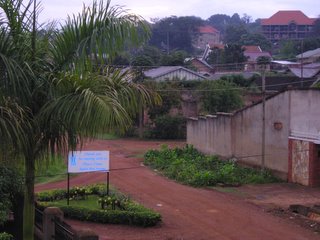
Birds are always the first indication of location. There were some tropical looking blue birds that had a loud, clear call. A hawk landed about 15 feet from me, and chickens were regulars on the street.
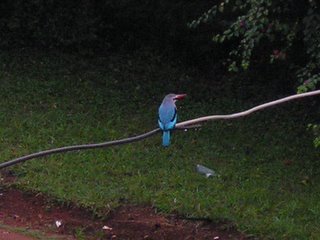
Stephen picked me up that morning, and we spent the day in Kampala. Kampala is quite the city. It is distinctly African and urban. The traffic is the first thing that I should mention. Cars go in the same general direction, but that is about the only rule that applies. There are multiple lanes in use on any two lane road, and passing rules are basically at your own risk. Stephen was a pro, and we wove our way into downtown. He said that I did particularly well as a Western passenger. Others he had taken in the past had uttered involuntary gasps during their first ride in the city.
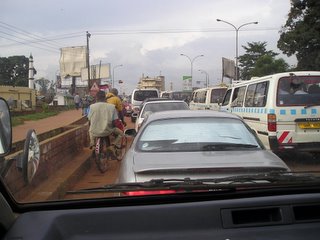
Kampala is also known for its storks. They are gigantic birds. I had never seen one in person, and I was shocked to find out that these three-foot tall creatures walk down the sidewalks and build their huge nests on billboards. Strange.
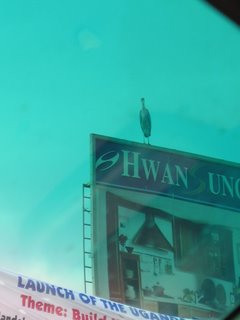
Stephen and I had lunch with his wife Grace and son Abraham. Grace teaches tailoring to widows in Kampala and Southern Sudan, so we chatted for quite a while about her projects. Stephen and Abraham took me back into the city for the tourist craft market, and they were very glad to realize that I was visiting during grasshopper season.
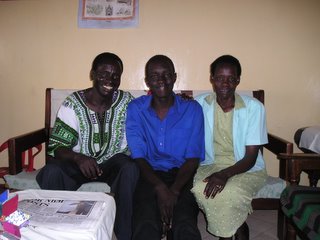
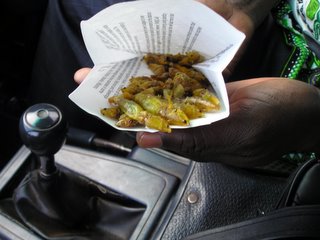
Ugandans love to eat fried grasshoppers. They are only sold for a month out of the year (immediately following the locust swarms), so we picked up a small bag of them for 500 shillings (about 30 cents). They weren't bad. They were easier to swallow when I didn't think about the little eyes and legs.
The next morning I had a flight up to Adjumani in Northern Uganda. That is where the rest of my team had arrived four days earlier, and it is the location of Amazing Grace Orphanage. Adjumani was the third stop on the prop plane flight. We took off from dirt runways and flew over hut villages. The land was much greener than I had imagined, and the bloom of spring made everything look lush from the air. I shared the little flight with a missionary family, UN workers, and an African terrorism specialist. I felt a bit, uh, underqualified in the crowd, but I enjoyed the variety of my company.
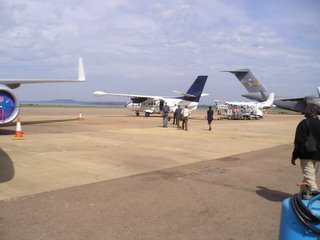
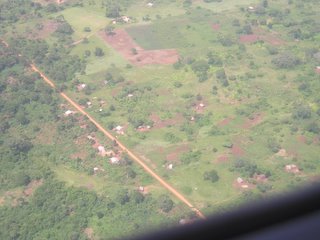
When I landed in Adjumani the entire team was waiting to greet me. I was incredibly glad to see them. We stopped for lunch at Amazing Grace and loaded the truck for our three hour trip North to St. Bartholomew's Orphanage in Kajo Keji, Sudan. We filled the back of the lorry with supplies, food, and luggage for the twenty or so travelers that were headed there.
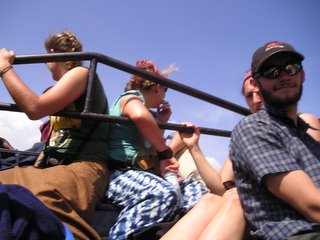
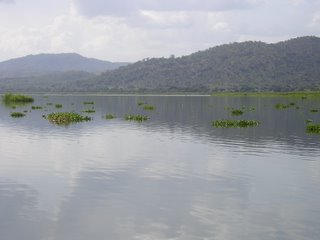
On our way to Sudan we crossed the Nile on a ferry. There were clumps of reeds floating down the river, and I could clearly imagine baby Moses being hidden there so long ago. On the northern shore we met an Austrian woman who insisted that we should not travel in Southern Sudan. She said that there had been significant trouble in the last two days, and that a Westerner had been shot by the LRA.
We had heard about trouble a week prior in a region considerably further west than Kajo Keji, but her warning was pretty startling to hear. However we had been keeping very close tabs on the area with our contacts in Sudan, and they insisted that there was no trouble anywhere near St. Bartholomew's. We found out later that the naysayer had just been confused about the location of those events, and she was overreacting because of that misinformation.
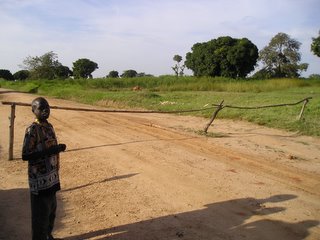
The border between Uganda and Sudan is a stick across the road with a one room immigration office. We had to pay some "extra fees" at the border, but we made it across with relatively little problem. The orphanage was only fifteen miles north of the border, and we enjoyed the dramatic beauty of Sudan's green hills and valleys from the back of the truck where we were riding. We saw many buildings that had been bombed out during the war, but it was exciting to see that there was an incredible amount of rebuilding going on. Every Sudanese refugee that I met talked about how anxious he or she was to get back to their mother land. There is an intense loyalty that draws the Southern Sudanese back home even after the atrocities of their civil war.
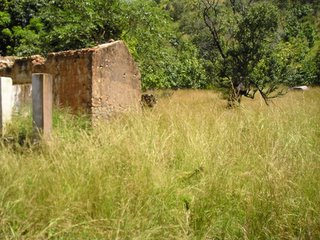
We arrived to a line of children singing at St. Bartholomew's. Long, long time ago to see you! We are really glad to see our visitors! was their song. I'll sing it for you in person if you ask. There are about 35 kids that live at St. Bartholomew's, and they range in age from about 5 to 13. I get weak just thinking about those kids. Their faces are deeply pressed into my heart.
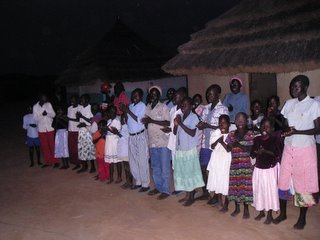
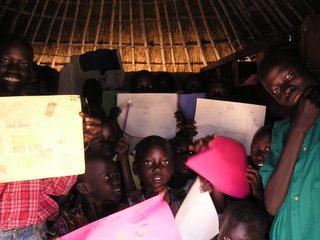
The next few days were really the heart of my trip. We loved on the kids, visited with widows in the area, passed out all the supplies that we brought, went to a leper colony, danced with the kids, and visited the farms run by the orphanage. At one point our truck got stuck in the mud. It took about two hours and fifteen extra strangers to get it out. Sudanese roads are notorious for their potholes and mud pits, but the locals were ready and willing to help us out of our mess.
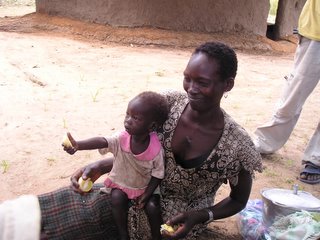
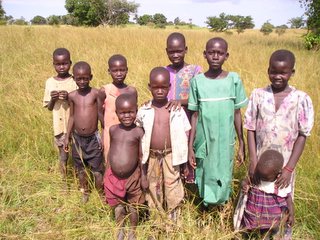

We also had time to meet with some local authorities. They were very optimistic about rebuilding Southern Sudan, but at this point it is operating almost independently from the Northern government. There is so much racial tension since the war. I really wonder if Sudan will be just Sudan for much longer.
I am so grateful that we were working with local leadership instead of exterior, Western organizations. We were able to see the good work of our amazing brothers and sisters as they sacrificially met the needs within their own community. I am entirely convinced that local leadership is the best option whenever possible. I cannot imagine a true partnership that functioned otherwise. The pictures below are of the amazing church leaders we worked with through the Church of Uganda: Mama Susan Tabia, Esbon Wudu and Emmanuel Lasu.
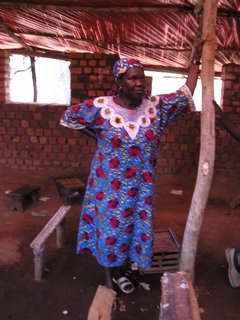
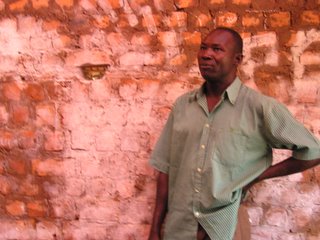
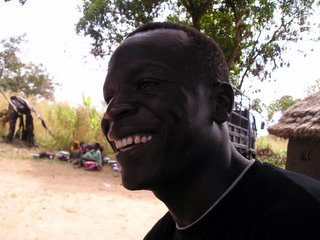
We were at St. Bartholomew's until the following Sunday when we drove back to Amazing Grace in Adjumani. We spent the night there and booked our tickets for bus heading south the following morning. Susan Tabia (Mama Susan) gave me a traditional dress made by the widows in the area. Her niece (also named Susan) did my hair for the occasion. I felt so loved by the women at the orphanages. I wish that I had been able to spend more time with each of them.
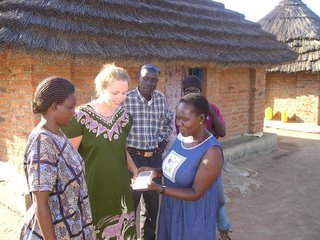
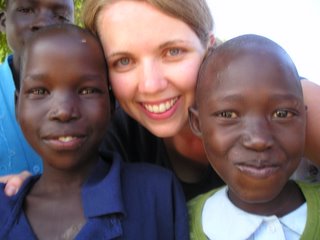
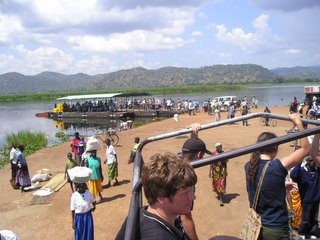
The bus ride from Adjumani to Kampala was memorable. It was eleven hours of having at least 15 people more than seats on an old bus in the hot sun. We broke down once, we had no official bathroom breaks, and we sweat a lot. The first leg was through a rough area, so we traveled with a military convey, and the second leg was an exhilirating race to pass cars before the oncoming semi trucks met up with us in their lane. Man oh man. I saw some baboons by the side of the road, and trip-mate Disa taught me some useful sign language.
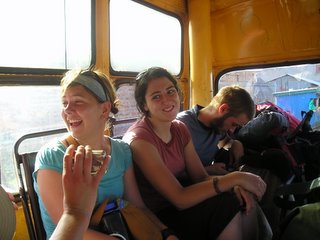
As we neared Kampala it was clear that there was some sort of problem in the city. People were flagging our bus and making slashing motions at their throat. One man simulated machine gun fire and pointed frantically in the direction of the city. It turned out that an opposition leader had been arrested by the president's men, and there were riots in the city. We off loaded before the trouble area, and we took a taxi to our hostel. We found out later that the worst of it had been tear gas and looting, but we were glad to stay out of the fray.
We spent a day at the home of our friend Emmanuel in Kampala, and then we said our sad goodbyes to Eric and Poni as they left to return to the States.
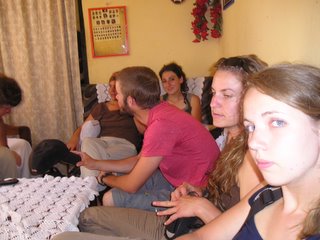
On Wednesday, November 16th, we took an overnight bus from Kampala to Nairobi, Kenya. It ended up being a 13 hour trip. I found that the most comfortable way to sleep seated while folding my body in half with my head between my knees and my jacket over my head to block the light and sound.
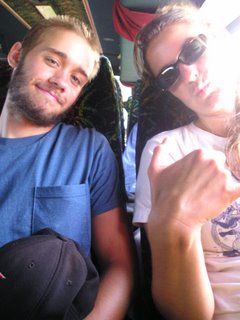
Nairobi seemed unbelievably developed in comparison to Uganda and Sudan. The city has paved streets and parking lots. It is funny to recognize what little characteristics symbolize familiarity to our minds. The city was busy preparing for the upcoming election on the constitution which took place this last Monday. The two sides identified themselves as either an Orange or a Banana; citizens even avoided eating the opposition fruit. I saw one march through the city, but I only caught the tail end with my camera.
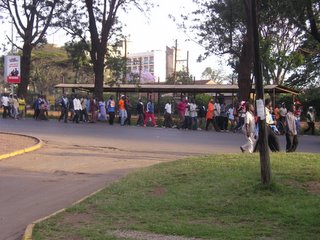
While we were in Nairobi, we met with a doctor that helps run AIDS prevention programming in some of the Kenyan slums. She was very supportive of local programming in the area, and she emphasized the importance of education for children as a critical piece of helping Kenya defeat AIDS. Many children cannot afford school fees, and their lack of education stagnates their ability to pull their families out of poverty.
That afternoon we walked through Kibera, the largest slum city in the world. Kibera is home to nearly 700,000 people, half of which are children. One in three residents of the slum is HIV positive. I have never known or experienced anything like what we saw, and I am still trying to figure out how to process it all.
We visited a school that was packed into three tiny rooms with mud walls. Each room held 50 students when in session, and the entire facility served 180 kids. The school matron that we met was named Margaret. She had given up her life in the city to live in the slums, and she had taken several AIDS orphans into her own home. She was one of the most joyful individuals that I have ever met, and yet she was faced with some of the most difficult issues I have ever known. She told us that there are at least 1000 more children that her school could immediately serve if they had the resources to do so.
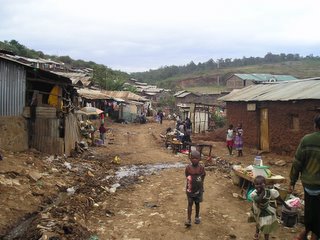

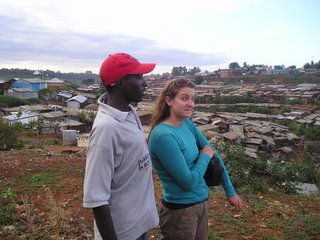
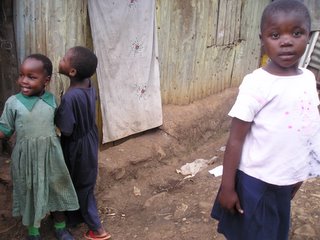
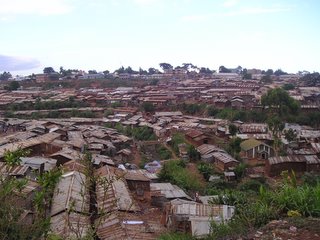
My last day in Kenya was fairly laid back. We picked up some tea and other souvenirs at the store, and we spent time journaling and resting at our hotel. I flew out at 11:30 PM on Saturday, November 19th, and I arrived in Seattle on the following Sunday at 5:00 PM after nearly 40 hours of travel. I had to go through extra security since I was young, alone, and traveling from East Africa. Apparently those factors made me look a bit more suspicious.
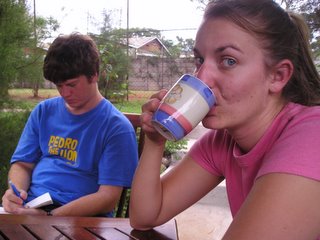
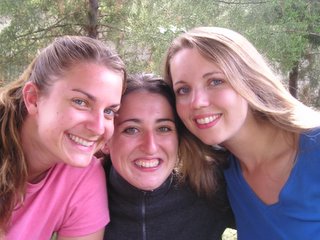
There is no way that I can write about my experiences without writing about my faith. I did not consider it any type of evangelistic trip because the organizations that I was visiting were already being run by local believers (not to mention my conflicting feelings about short-term mission trips). Instead, I think I've decided to call it a Body of Christ trip. I was able to see and support the good work of the global church. It made my faith feel much bigger to know that I am connected to them through the metaphysical bond of our common belief in Christ.
I had somewhat arbitrarily decided to read the book of Isaiah on the plane trip over, and I was struck by God's overwhelming emphasis on serving orphans and widows. If I am truly trying to be the hands of Christ, how could I distract myself with anything else? I could go on and on with this, but I'm still trying to let that truth process in my heart.
I wish that the trip could have lasted longer, but it is good to be home. My prayer is that the things that I learned and saw in East Africa will continue to actively shape my life. I don't want to settle with simplistic answers about war, poverty, or injustice. It is too easy to push the truth about life and humanity into a photo album (or blog post, for heaven's sake) and consider it finished. More than anything, I want to avoid allowing this experience to become "My trip to Africa." Instead, I hope that it is simply one step in a much longer journey.

I arrived in Entebbe, Uganda on Monday, November 7th. It was early in the morning, and the airport is a small-town sized facility (only two stories and two main gates). After collecting my bag and shuffling through immigration, I made my way toward the pick-up strip full of taxis and my anticipated ride to a hotel.
The arrangements for my pick-up had changed at the last minute, and I had fuzzy details about an airport hotel that should have met me at the gate. After about an hour of juggling luggage and walking around, I realized that there was no one waiting for me. The airport had cleared except for a few taxi drivers that were considerably helpful (although likely in anticipation of my business).
A few phonecalls got me to a hotel that sounded like the right one. I checked in, and called my parents who were reasonably trying not to panic after the "don't panic, I will call you by 11:00 PM your time" had passed by twenty minutes. There were speed bumps with my bank card and phone card, but solutions were eventually found for every hitch.
My contact in Kampala (twenty minutes from Entebbe) was a Sudanese refugee named Stephen Tomor who currently lives in Southern Uganda. He found his way to my hotel, and greeted me like an old friend. It was wonderful to be met by someone who was expecting me after 40+ hours of travel on my own. Stephen came by to get details for our Sudanese visas, and he left me to sleep for the next 16 hours.
I woke up very early on Tuesday, and I went up to the hotel balcony to gauge my surroundings. I was up in time to see the seventeen year old(ish) guard swing his rifle over his back and pedal away into town.

Birds are always the first indication of location. There were some tropical looking blue birds that had a loud, clear call. A hawk landed about 15 feet from me, and chickens were regulars on the street.

Stephen picked me up that morning, and we spent the day in Kampala. Kampala is quite the city. It is distinctly African and urban. The traffic is the first thing that I should mention. Cars go in the same general direction, but that is about the only rule that applies. There are multiple lanes in use on any two lane road, and passing rules are basically at your own risk. Stephen was a pro, and we wove our way into downtown. He said that I did particularly well as a Western passenger. Others he had taken in the past had uttered involuntary gasps during their first ride in the city.

Kampala is also known for its storks. They are gigantic birds. I had never seen one in person, and I was shocked to find out that these three-foot tall creatures walk down the sidewalks and build their huge nests on billboards. Strange.

Stephen and I had lunch with his wife Grace and son Abraham. Grace teaches tailoring to widows in Kampala and Southern Sudan, so we chatted for quite a while about her projects. Stephen and Abraham took me back into the city for the tourist craft market, and they were very glad to realize that I was visiting during grasshopper season.


Ugandans love to eat fried grasshoppers. They are only sold for a month out of the year (immediately following the locust swarms), so we picked up a small bag of them for 500 shillings (about 30 cents). They weren't bad. They were easier to swallow when I didn't think about the little eyes and legs.
The next morning I had a flight up to Adjumani in Northern Uganda. That is where the rest of my team had arrived four days earlier, and it is the location of Amazing Grace Orphanage. Adjumani was the third stop on the prop plane flight. We took off from dirt runways and flew over hut villages. The land was much greener than I had imagined, and the bloom of spring made everything look lush from the air. I shared the little flight with a missionary family, UN workers, and an African terrorism specialist. I felt a bit, uh, underqualified in the crowd, but I enjoyed the variety of my company.


When I landed in Adjumani the entire team was waiting to greet me. I was incredibly glad to see them. We stopped for lunch at Amazing Grace and loaded the truck for our three hour trip North to St. Bartholomew's Orphanage in Kajo Keji, Sudan. We filled the back of the lorry with supplies, food, and luggage for the twenty or so travelers that were headed there.


On our way to Sudan we crossed the Nile on a ferry. There were clumps of reeds floating down the river, and I could clearly imagine baby Moses being hidden there so long ago. On the northern shore we met an Austrian woman who insisted that we should not travel in Southern Sudan. She said that there had been significant trouble in the last two days, and that a Westerner had been shot by the LRA.
We had heard about trouble a week prior in a region considerably further west than Kajo Keji, but her warning was pretty startling to hear. However we had been keeping very close tabs on the area with our contacts in Sudan, and they insisted that there was no trouble anywhere near St. Bartholomew's. We found out later that the naysayer had just been confused about the location of those events, and she was overreacting because of that misinformation.

The border between Uganda and Sudan is a stick across the road with a one room immigration office. We had to pay some "extra fees" at the border, but we made it across with relatively little problem. The orphanage was only fifteen miles north of the border, and we enjoyed the dramatic beauty of Sudan's green hills and valleys from the back of the truck where we were riding. We saw many buildings that had been bombed out during the war, but it was exciting to see that there was an incredible amount of rebuilding going on. Every Sudanese refugee that I met talked about how anxious he or she was to get back to their mother land. There is an intense loyalty that draws the Southern Sudanese back home even after the atrocities of their civil war.

We arrived to a line of children singing at St. Bartholomew's. Long, long time ago to see you! We are really glad to see our visitors! was their song. I'll sing it for you in person if you ask. There are about 35 kids that live at St. Bartholomew's, and they range in age from about 5 to 13. I get weak just thinking about those kids. Their faces are deeply pressed into my heart.


The next few days were really the heart of my trip. We loved on the kids, visited with widows in the area, passed out all the supplies that we brought, went to a leper colony, danced with the kids, and visited the farms run by the orphanage. At one point our truck got stuck in the mud. It took about two hours and fifteen extra strangers to get it out. Sudanese roads are notorious for their potholes and mud pits, but the locals were ready and willing to help us out of our mess.



We also had time to meet with some local authorities. They were very optimistic about rebuilding Southern Sudan, but at this point it is operating almost independently from the Northern government. There is so much racial tension since the war. I really wonder if Sudan will be just Sudan for much longer.
I am so grateful that we were working with local leadership instead of exterior, Western organizations. We were able to see the good work of our amazing brothers and sisters as they sacrificially met the needs within their own community. I am entirely convinced that local leadership is the best option whenever possible. I cannot imagine a true partnership that functioned otherwise. The pictures below are of the amazing church leaders we worked with through the Church of Uganda: Mama Susan Tabia, Esbon Wudu and Emmanuel Lasu.



We were at St. Bartholomew's until the following Sunday when we drove back to Amazing Grace in Adjumani. We spent the night there and booked our tickets for bus heading south the following morning. Susan Tabia (Mama Susan) gave me a traditional dress made by the widows in the area. Her niece (also named Susan) did my hair for the occasion. I felt so loved by the women at the orphanages. I wish that I had been able to spend more time with each of them.



The bus ride from Adjumani to Kampala was memorable. It was eleven hours of having at least 15 people more than seats on an old bus in the hot sun. We broke down once, we had no official bathroom breaks, and we sweat a lot. The first leg was through a rough area, so we traveled with a military convey, and the second leg was an exhilirating race to pass cars before the oncoming semi trucks met up with us in their lane. Man oh man. I saw some baboons by the side of the road, and trip-mate Disa taught me some useful sign language.

As we neared Kampala it was clear that there was some sort of problem in the city. People were flagging our bus and making slashing motions at their throat. One man simulated machine gun fire and pointed frantically in the direction of the city. It turned out that an opposition leader had been arrested by the president's men, and there were riots in the city. We off loaded before the trouble area, and we took a taxi to our hostel. We found out later that the worst of it had been tear gas and looting, but we were glad to stay out of the fray.
We spent a day at the home of our friend Emmanuel in Kampala, and then we said our sad goodbyes to Eric and Poni as they left to return to the States.

On Wednesday, November 16th, we took an overnight bus from Kampala to Nairobi, Kenya. It ended up being a 13 hour trip. I found that the most comfortable way to sleep seated while folding my body in half with my head between my knees and my jacket over my head to block the light and sound.

Nairobi seemed unbelievably developed in comparison to Uganda and Sudan. The city has paved streets and parking lots. It is funny to recognize what little characteristics symbolize familiarity to our minds. The city was busy preparing for the upcoming election on the constitution which took place this last Monday. The two sides identified themselves as either an Orange or a Banana; citizens even avoided eating the opposition fruit. I saw one march through the city, but I only caught the tail end with my camera.

While we were in Nairobi, we met with a doctor that helps run AIDS prevention programming in some of the Kenyan slums. She was very supportive of local programming in the area, and she emphasized the importance of education for children as a critical piece of helping Kenya defeat AIDS. Many children cannot afford school fees, and their lack of education stagnates their ability to pull their families out of poverty.
That afternoon we walked through Kibera, the largest slum city in the world. Kibera is home to nearly 700,000 people, half of which are children. One in three residents of the slum is HIV positive. I have never known or experienced anything like what we saw, and I am still trying to figure out how to process it all.
We visited a school that was packed into three tiny rooms with mud walls. Each room held 50 students when in session, and the entire facility served 180 kids. The school matron that we met was named Margaret. She had given up her life in the city to live in the slums, and she had taken several AIDS orphans into her own home. She was one of the most joyful individuals that I have ever met, and yet she was faced with some of the most difficult issues I have ever known. She told us that there are at least 1000 more children that her school could immediately serve if they had the resources to do so.





My last day in Kenya was fairly laid back. We picked up some tea and other souvenirs at the store, and we spent time journaling and resting at our hotel. I flew out at 11:30 PM on Saturday, November 19th, and I arrived in Seattle on the following Sunday at 5:00 PM after nearly 40 hours of travel. I had to go through extra security since I was young, alone, and traveling from East Africa. Apparently those factors made me look a bit more suspicious.


There is no way that I can write about my experiences without writing about my faith. I did not consider it any type of evangelistic trip because the organizations that I was visiting were already being run by local believers (not to mention my conflicting feelings about short-term mission trips). Instead, I think I've decided to call it a Body of Christ trip. I was able to see and support the good work of the global church. It made my faith feel much bigger to know that I am connected to them through the metaphysical bond of our common belief in Christ.
I had somewhat arbitrarily decided to read the book of Isaiah on the plane trip over, and I was struck by God's overwhelming emphasis on serving orphans and widows. If I am truly trying to be the hands of Christ, how could I distract myself with anything else? I could go on and on with this, but I'm still trying to let that truth process in my heart.
I wish that the trip could have lasted longer, but it is good to be home. My prayer is that the things that I learned and saw in East Africa will continue to actively shape my life. I don't want to settle with simplistic answers about war, poverty, or injustice. It is too easy to push the truth about life and humanity into a photo album (or blog post, for heaven's sake) and consider it finished. More than anything, I want to avoid allowing this experience to become "My trip to Africa." Instead, I hope that it is simply one step in a much longer journey.

6 Comments:
Thank you, thank you, thank you for providing a much needed break in my day. What a gift your story is! I share in so many of your thoughts, but most closely in your desire to not box the experience as "My trip to Africa." Western culture has us dividing our experiences, our daily lives and our interaction with God Himself into mere blocks of time - little boxes with labels that tidily fit into our shelving of memories. Life isn't tidy and neither is God. It is so evident that the time you spent in Uganda, Sudan, and Kenya is a part of the beautiful story that God is continuing to write for your life. I am SO thankful that I had the opportunity to share in a little peice of it with you! :)
Epic Epic Epic! Good summary of the experience.
Wow. I'm completely in awe. Beautiful pictures, what beautiful people! Thanks so much Erin.
I'm just glad to share it with you all!
And I'm glad that you wanted to share this part of your life with all of us. A "Body of Christ" trip indeed.... I need to decide when I will be taking mine and for how long it might last....
I enjoyed every word - thanks for sharing it.
Post a Comment
<< Home